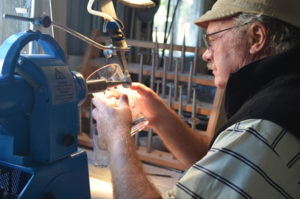 Peter Cummings has lived in many places but is now settled in Gippsland. “I can’t stand the thought of moving again – it would mean packing all the boxes.” If he did decide to move unlike most of us who would have all sorts of bits and pieces, Peter’s boxes would be predominantly filled with the books, tools and the products of his craft of creating exquisite glass objects.
Peter Cummings has lived in many places but is now settled in Gippsland. “I can’t stand the thought of moving again – it would mean packing all the boxes.” If he did decide to move unlike most of us who would have all sorts of bits and pieces, Peter’s boxes would be predominantly filled with the books, tools and the products of his craft of creating exquisite glass objects.
As a young child, Peter used to go fossicking around the Cardinia Dam and would often find sparkling stones. He was sure he was going to be a jeweller but his father was equally sure that would not be the case. Instead Peter worked in a plant nursery in the 1970s and as he put it, “was on the trail in a happy, hippy way to make the world a better place.” That led him to take on the much more serious role of welfare worker. After ten years of trying to help the marginalised in our society, Peter was worn out. He escaped to a tiny cottage in the back blocks of Bendigo where he could rejuvenate.
And that meant using the skills he learned in the nursery to turn the overgrown cottage’s block into a garden. As he dug he came across a cabochon. And in this domed piece of polished glass he saw that flowers had been moulded into it. It was this tiny find that started Peter on his journey of creating imagery in glass. He bought the cheapest drill that he could find and sought to create his own flowers.
As he learnt more and developed new techniques he realised that in order to fund his passion he would have to find work. He worked wherever he could – from hotel/motels to bacon factories and chicken farms. He even worked in an orthodontic factory where his carving skills were found to be quite useful as he was required to carve the plastics down to 1 mm.
When Peter started engraving glass, it was an ancient and generally believed dying art form. In those early days however the Guild of Glass Engravers had been formed in Britain in order to re-invigorate the art of creative design and craftsmanship in glass engraving.
Unfortunately, no such guild existed then or now here in Australia and that has meant that Peter has struggled with his chosen field. He has had to battle with non-acceptance of his work because, as an example, a piece that he has carved on a bubble of glass is then blown by someone else – a glass blower – and therefore not all his own work. This is similar to saying that a painting will not be accepted because the artist has not made the canvas on which he paints.
Sometimes a gallery will not accept his work because he does not have tertiary qualifications. It reminds me somewhat when I was working as an HR consultant for a firm that proudly showed me their recruitment process which included culling applicants based on a score for each of the selection criteria. Qualifications was one of the criteria and it was worth 50 points out of 100. I asked if that meant that if someone applied to be a cleaner and they had a PhD that they would in all likelihood get the position even if they couldn’t clean. The response was an embarrassed, “Yes …”
Peter is always experimenting – whether in glass or trying other medium such as wood carving and painting – with each piece telling a story. Having worked as a welfare officer for so long, and having had a difficult upbringing, many of the pieces have a dark side to them. His current theme is fragile masculinity. His favourite at the moment is called “Indestructible Male”. It is an electronic key shaped like a coffin representing the young men who die feeling indestructible on the road.
One of his paintings is of Prometheus, from Greek mythology, whose punishment was to have an eagle feed on his liver. The liver grew back overnight only to be eaten again the next day. Peter’s modern take on this is to acknowledge the torture that drug addicts must face as the need for drugs eats into them every day.
For me, though, it is the cut and carved glassware that is the most beautiful. And in particular the fused glassware. Peter takes panels of glass, fuses them together and then carves into the layers, exposing the coloured glass behind. They are like versions of the cameo brooches that we know so well – but on a much larger scale. They are exquisite.
Just as I am about to say goodbye to Peter he surprises me when he says that he believes in the Holy Trinity. He clarifies that for him it has a different meaning to one we are used to. It is the trinity of the artist, the work and the viewer. All three are needed in order to appreciate art. For Peter, his life after death is not a soul going to heaven, but his evocative works here on earth that pose questions for each of us to answer.


2 Responses
Jack Whadcoat
I want to know more of this artist and his intricate knowledge in working with moulded sand–Glass.
Aleida Jansen
Thank you for asking about Peter Cummings’ beautiful glass work. You can discover more on his website: https://glasspeter.wordpress.com/
Enjoy.
Aleida
ArtSpace Website Admin